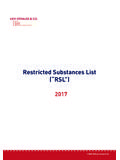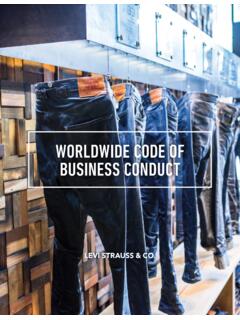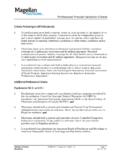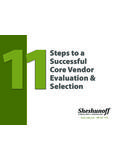Transcription of WORKER WELL-BEING IMPLEMENTATION GUIDEBOOK
1 WORKER well -BEINGIMPLEMENTATION GUIDEBOOKTABLEOF AND THE COMPANY S LONG-TERM SUPPLY CHAIN vendor WELL-BEING PROGRAM MONITORING AND EVALUATION OF WORKER AND was conceived by LS&Co. as a new approach to supply chain engagement. WWB goes beyond labor compliance and collaborates with suppliers to implement programs that improve the lives of apparel workers. LS&Co. believes that investments in WORKER WELL-BEING enable a more conducive business environment, generating shared value for workers and drive improvements to WORKER and community WELL-BEING , WWB sets more holistic expectations for suppliers. Over time, LS&Co. expects that all its vendors implement WORKER programs that go beyond legal and Terms of Engagement (TOE) requirements and that respond to workers needs that often manifest themselves beyond factory walls.
2 WWB asks that vendors communicate with workers, identify local challenges, develop and implement appropriate WORKER programs and forge partner-ships to generate and sustain lasting impacts. To assist with the IMPLEMENTATION and dissemination of WWB, this GUIDEBOOK : Presents LS&Co. s long-term vision for its supply chain as it relates to WORKER WELL-BEING . Communicates the details of WWB to vendors and external stakeholders, including vendor selection criteria, expectations for IMPLEMENTATION of WORKER programs and WWB validation standards. Outlines the responsibilities for companies and vendors as it relates to WWB. This GUIDEBOOK presents information on the Levi Strauss & Co. (LS&Co.) WORKER WELL-BEING (WWB), a supply chain initiative introduced by LS&Co. to raise the living standards of workers through partnerships with strategic vendors.
3 The GUIDEBOOK outlines the criteria for vendor selection into WWB, IMPLEMENTATION standards and requirements for validation of vendor pro-grams. The guidelines in this document are applicable to all LS&Co. vendors and we expect that, with time, all supply chain partners meet these the last 15 years LS&Co. has invested $ million in grants to advance the rights and wellbeing of apparel workers in 16 key sourcing countries, building collaborations with brands, suppliers and local organizationsIn 2011, the company announced its commitment to a new approach to engage suppliers and create local, factory-level programs to address WORKER WELL-BEING and WWB was introducedIn 1991, LS&Co. became the first apparel company to develop a comprehensive code of conduct for its suppliers based on inter-nationally recognized standards, known as the Terms of Engagement (TOE) Since 2011, WWB has been piloted with 5 suppliers in Bangladesh, Cambodia, Egypt, Haiti and Pakistan3LS&Co.
4 Has long held the belief that its success as a company is directly tied to innovation and setting higher standards for it-self and its business partners. WWB is yet another step forward and expands the company s efforts to better the lives of workers around the world and build a more holistic business model. LS&Co. intends to allocate a greater percentage of cost of goods to model vendors those that proactively manage sustainable products and programs, are leaders in their industries, and deliver a resilient and efficient supply chain. While some vendors already demonstrate this leadership, LS&Co. expects that current vendors evolve their businesses and that newly selected vendors fit this model profile. WWB is an integral part of this supply chain evolution. Model vendors see WORKER WELL-BEING as critical to the business and understand the value of investing in their workforce.
5 Model vendors understand that improved WELL-BEING can lead to greater efficiency and productivity and increased supply chain reliability. LS&Co. believes that deeper partnerships with model vendors on sustainability and WORKER WELL-BEING will lead to a stronger supply chain. As a means to continue to impact the lives of workers around the world, we see this as the logical next step. WWB AND THE COMPANY S LONG-TERM SUPPLY CHAIN STRATEGYSUPPLY CHAIN EVOLUTIONThis section of the GUIDEBOOK lays out LS&Co. s long-term supply chain strategy, serving to inform vendors of the Company s business expectations so these can be incorporated into our vendors long-term draws inspiration from and builds upon the Levi Strauss Foundation s (LSF) successful track record of supporting WORKER empowerment programs and LS&Co. s Sustainability team s work on workplace conditions over the past two vendor : Meets legal requirements and/or LS&Co.
6 Standards, whichever is stricter. vendor delivers the basic and foundational production and sustainability vendor : Has internal team and systems to manage compliance and risks consistently and with limited support. Management systems and certifications are in place. vendor tracks performance through key vendor : Proactively manages sustainable products and programs that are engaging directly with consumers, clients, and the industry. vendor is leader in public disclosure and reporting and other ethical and sustainable BUSINESS CASE FOR WORKER well -BEINGW orker WELL-BEING initiatives can increase the quality of life of workers and translate the benefits of healthy and happy employees into meaningful business impacts. At the individ-ual level, improved WELL-BEING can result in healthier, hap-pier, safer, more educated and financially stable workers.
7 Businesses benefit from increases in employee engage-ment ( retention), productivity, reductions in employee absenteeism and decreases in ancillary expenses such as legal or healthcare costs. WORKER WELL-BEING initiatives thus transcend to the greater community and lead to a virtuous cycle for workers and the business. Below are examples of the documented business impacts that investing in WORKER WELL-BEING can generate: HERproject, an initiative led by BSR, empowers low-in-come women working in global supply chains through programs that promote health, economic empowerment, and women s rights. - A 2006 study in a Bangladesh factory found a US$4 to US$1 ROI for women s health education and clinic services program. Benefits materialized in the form of reduced turnover and absenteeism.
8 - At a factory in Mexico, 47 peer educators were trained on general and reproductive health and shared their knowledge with 1,090 female co-workers. Women reported more regular doctor visits, which led to reductions in new employee disability claims and better WORKER relations. - A factory in Pakistan implemented HERproject to edu-cate workers about family planning and sexual health and provided sanitary napkins at a subsidized cost. As a result, the factory reported reduced health com-plaints and women reported a 25% reduction in poor concentration at work, 28% less absenteeism related to menstruation, and 33% less difficulty in meeting production targets. An initial ROI analysis found that employees worked an average of more hours per month during the project period, representing an ad-ditional 615 days of work per year.
9 Extending Service Delivery, a health program funded by USAID, conducted a study to determine the ROI for a Ban-gladesh garment factory that introduced onsite health services for its workers. The study found that the factory saved $3 for every $1 spent on health services. Savings were calculated based on workers reporting they were COMPLIANT VENDORS cope and reach of WORKER programs: WORKER programs meet certain local needs, but overemphasize infrastructure and un-deremphasize skills building, have limited to no sustainability outlook, there is no monitoring and evaluation of results, and no multi-stakeholder VENDORS cope and reach of WORKER programs: WORKER programs meet local needs, community programs respond to local requests in an ad hoc manner, limited local stakeholder participation, some monitoring and/or evaluation of programs in place, and limited focus on VENDORS cope and reach of WORKER programs.
10 System in place to identify workers needs and prioritize programs, development of programs respond to local needs, programs extend to the community, are embedded in the company s strategy, results are measured and communicated, programs are sustainable, and multi-stakeholder partnerships are in OF WORKER PROGRAMS5 less likely to miss or leave work once health services were available. A microfinance program implemented by CARE Interna-tional in apparel factories provided workers access to loans for healthcare, education, or income-generating activities. The program led to increased retention as well as increased productivity, higher quality products, and supplier reliability. Programs to provide access to clean drinking water and hygiene education to factory workers have led to reduc-tions in employee illnesses and increases in WORKER productivity.











